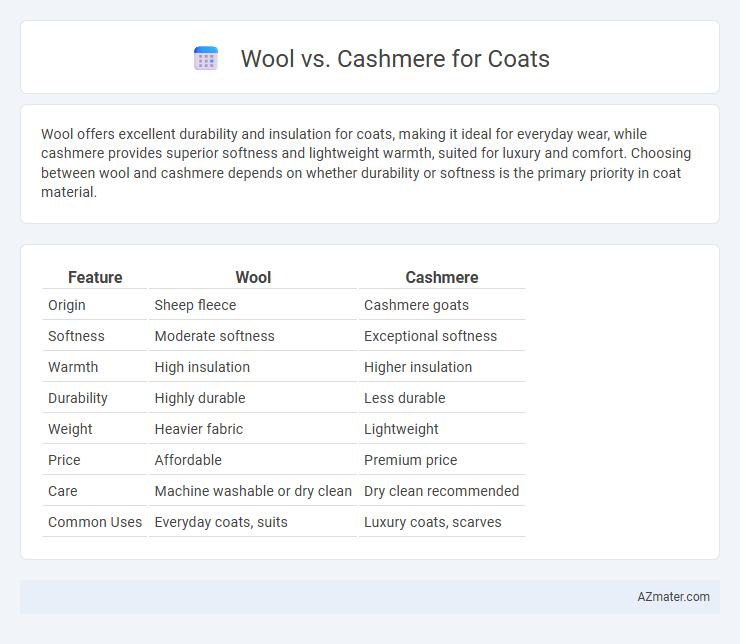Wool offers excellent durability and insulation for coats, making it ideal for everyday wear, while cashmere provides superior softness and lightweight warmth, suited for luxury and comfort. Choosing between wool and cashmere depends on whether durability or softness is the primary priority in coat material.
Table of Comparison
| Feature | Wool | Cashmere |
|---|---|---|
| Origin | Sheep fleece | Cashmere goats |
| Softness | Moderate softness | Exceptional softness |
| Warmth | High insulation | Higher insulation |
| Durability | Highly durable | Less durable |
| Weight | Heavier fabric | Lightweight |
| Price | Affordable | Premium price |
| Care | Machine washable or dry clean | Dry clean recommended |
| Common Uses | Everyday coats, suits | Luxury coats, scarves |
Introduction: Wool vs Cashmere for Coats
Wool and cashmere are two premium materials commonly used for coats, each offering distinct qualities in warmth and texture. Wool provides durability and excellent insulation, making it suitable for cold climates and everyday wear. Cashmere, derived from goat undercoat fibers, is softer and lighter, delivering luxurious comfort and superior thermal regulation for high-end outerwear.
Origin and Sourcing of Wool and Cashmere
Wool is primarily sourced from sheep raised in diverse regions such as Australia, New Zealand, and the UK, known for their high-quality Merino and Shetland breeds. Cashmere originates from the fine undercoat of Cashmere goats primarily found in Mongolia, China, and Nepal, prized for its softness and rarity. The sourcing process for cashmere is labor-intensive, involving delicate combing during spring molting, contributing to its premium status compared to the more abundant and widely farmed wool.
Texture and Feel: Wool vs Cashmere
Cashmere offers an exceptionally soft and luxurious texture, characterized by its fine, silky fibers that provide a plush and smooth feel against the skin. Wool, while also warm and durable, tends to have a coarser texture with a slightly rougher surface, making it less gentle compared to cashmere. The softness and lightweight nature of cashmere make it a preferred choice for those seeking comfort and elegance in coat fabrics.
Warmth and Insulation Properties
Cashmere offers superior warmth and insulation compared to traditional wool due to its finer, softer fibers that trap heat more effectively while remaining lightweight. Wool, especially merino wool, provides excellent thermal regulation and moisture-wicking properties, making it a durable and resilient choice for coats in varying temperatures. Cashmere coats excel in insulation for cold climates but require more delicate care, whereas wool coats balance warmth with practicality and durability.
Durability and Longevity Comparison
Wool coats offer superior durability due to their dense fiber structure, making them resistant to wear and suitable for everyday use in various weather conditions. Cashmere, while prized for its softness and luxury, is more delicate and prone to pilling, requiring more careful maintenance to preserve its longevity. Choosing wool ensures long-term resilience and cost-effectiveness, whereas cashmere demands gentle care to maintain its elegant appearance over time.
Weight and Breathability Factors
Wool coats provide excellent insulation with moderate weight, offering durability and natural moisture-wicking properties that enhance breathability. Cashmere coats are lighter and softer, delivering superior warmth while maintaining higher breathability due to finer fibers that allow better air circulation. Choosing between wool and cashmere depends on prioritizing lightweight comfort with premium softness or rugged durability with balanced breathability.
Style, Elegance, and Appearance
Cashmere coats exude unparalleled elegance with their smooth texture and natural sheen, offering a sophisticated and luxurious appearance. Wool coats provide a classic, structured style with excellent durability and a versatile look suitable for both formal and casual wear. The refined softness of cashmere enhances a polished silhouette, while wool's variety in weaves and finishes ensures timeless style and warmth.
Care, Maintenance, and Cleaning Tips
Wool coats require regular brushing to remove dirt and prevent matting, along with gentle spot cleaning using cold water and mild detergent to maintain fiber integrity. Cashmere coats demand more delicate care, including hand washing in cool water or professional dry cleaning to preserve softness and prevent shrinkage. Storing both fabrics in breathable garment bags and avoiding prolonged exposure to direct sunlight helps maintain their texture and color longevity.
Price Point: Wool vs Cashmere Investment
Wool coats generally offer a more affordable price point compared to cashmere, making wool a popular choice for budget-conscious consumers seeking warmth and durability. Cashmere, known for its luxuriously soft texture and superior insulation, commands a higher investment reflecting its premium quality and exclusivity. Choosing between wool and cashmere depends on balancing comfort and long-term value with the initial financial outlay.
Choosing the Right Material for Your Needs
Wool coats offer durability, warmth, and water resistance, making them ideal for everyday wear and harsh winter conditions, while cashmere provides superior softness, lightweight insulation, and a luxurious feel suited for mild cold and formal occasions. Cashmere's fine fibers ensure exceptional comfort but require more delicate care and typically come at a higher price point compared to the robust and more affordable wool options. Selecting between wool and cashmere depends on your climate, budget, maintenance preferences, and the coat's intended use, balancing practicality with luxury.

Infographic: Wool vs Cashmere for Coat
 azmater.com
azmater.com